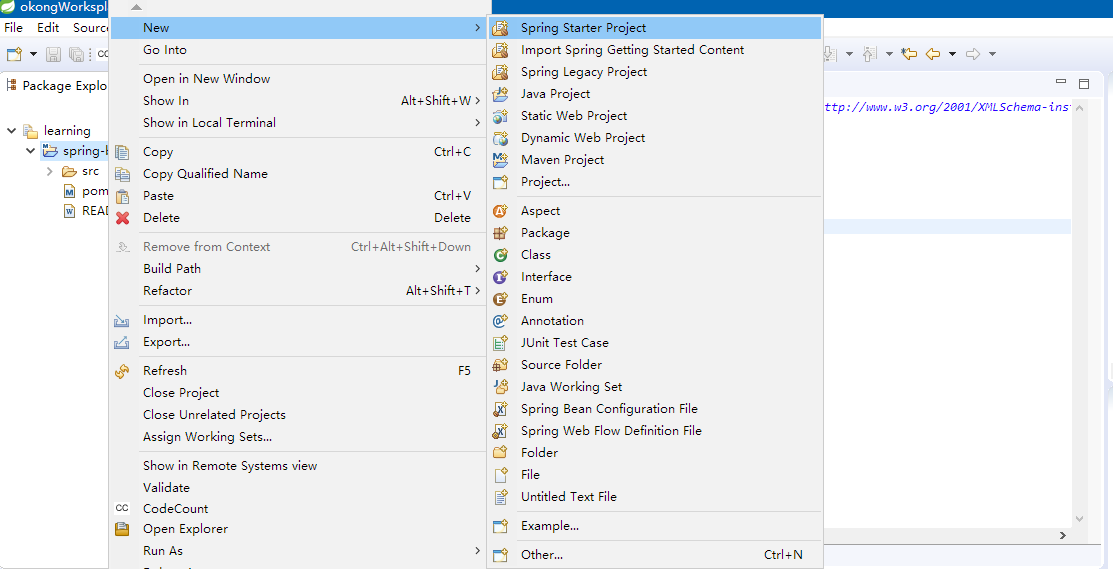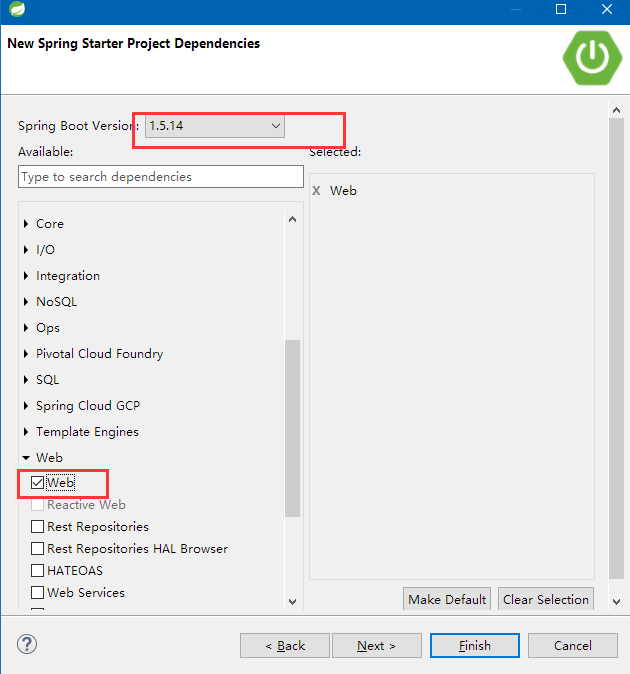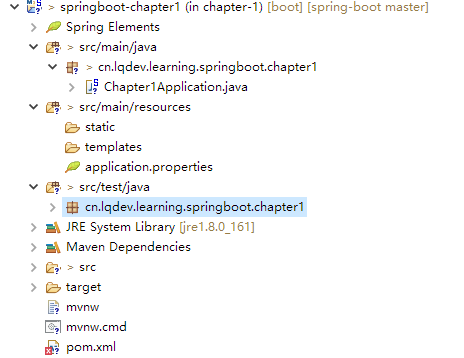SpringBoot | 第一章:第一个SpringBoot应用
1 | <br> |
springboot简单介绍
概述
随着动态语言的流行(Ruby、Groovy、Scala、Node.js),Java的开发显得格外的笨重:繁多的配置、低下的开发效率、复杂的部署流程以及第三方技术集成难度大。
在上述环境下,Springboot应运而生。它使用”习惯优于配置”(项目中存在大量的配置,此外还内置一个习惯性的配置,让你无须手动进行配置)的理念让你的项目快速运行起来。使用springboot很容易创建一个独立运行(运行jar,内嵌servlet容器)、准生产级别的基于Spring框架的项目,使用springboot你可以不用或者只需要很少的Spring配置。
Spring Boot 的核心功能
独立运行的Spring项目
Spring Boot可以以jar包的形式独立运行,运行一个Spring Boot项目只需要通过java -jar xx.jar。
内置Servlet容器
Spring Boot可选择内嵌Tomcat、Jetty或者Undertow,这样无须以war包形式部署。
提供starter简化maven配置
Spring提供了一系列的starter pom来简化maven依赖加载,例如:当你使用了spring-boot-starter-web时,会自动加入相关依赖,无需你手动一个一个的添加坐标依赖。
自动配置Spring
Spring Boot会根据在类路径中的jar包、类,为jar包里的类自动配置Bean,这样会极大地减少我们要使用的配置。当然,Spring Boot只是考虑了大多数的开发场景,并不是所有场景,若在实际开发中,我们需要自动配置bean,而Spring Boot没有提供支持,则可以自定义自动配置。
无代码生成和xml配置
Spring Boot的神奇的不是借助于代码生成来实现的,而是通过条件注解来实现的,这是Spring 4.x提供的新特性,Spring 4.x提倡使用java配置和注解配置相结合,而Spring Boot不需要任何xml配置即可实现Sping Boot的所有配置。
优缺点
优点
快速构建项目:省略了繁琐且重复的xml配置,分分钟构建一个web工程;
对主流开发框架的无配置集成:提供了很多Starter 依赖包,开箱即用,无需多余配置;
项目可独立运行:无需外部依赖Servlet容器;
极大地提供了开发、部署效率;
监控简单:提供了actuator包,可以使用它来对你的应用进行监控。
缺点
依赖太多:一个简单的SpringBoot应用都有好几十M只有;
缺少监控集成方案、安全管理方案:只提供基础监控,要实现生产级别的监控,监控方案需要自己动手解决;(后期讲解
soringCloud时,会结合pinpoint和skywalking分布式链路工具进行应用监控)
工程搭建
使用的工具为:
Spring Tool Suite(3.9.3.RELEASE)
SpringBoot:1.5.14.RELEASE
Spring Tool Suite 下载地址:https://spring.io/tools/sts/all
创建项目
利用
Spring Initializr进行快速创建项目
选择
Dashboard–>CREATE SPRING STARTER PROJECT进行创建项目,或者可以选择file–>new–>Spring Starter Project,打开创建面板
第一种方式:
出现创建面板,填写项目信息
这里url建议直接填写:
https://start.spring.io(默认是http方式)
maven相关命名说明
Group:一般为逆向域名格式,如本博客域名为lqdev.cn,则group一般以cn.lqdev开头Artifact:唯一标识,一般为项目名称。
具体maven相关信息,可自行搜索,这里只简单阐述
选择依赖包和版本
除此下载包时,可能会比较慢,建议替换成阿里云的maven镜像
项目结构
1 2 3 4 5 6 7 8 9 10 11 12 13 14 15 16 17 | - src -main -java -cn.lqdev.learning.springboot.chapter1 #主函数,启动类,运行它如果运行了 Tomcat、Jetty、Undertow 等容器 -Chapter1Application -resouces #存放静态资源 js/css/images 等 - statics #存放 html 模板文件 - templates #主要的配置文件,SpringBoot启动时候会自动加载application.properties/bootstrap.properties - application.properties #测试文件存放目录 -test # pom.xml 文件是Maven构建的基础,里面包含了我们所依赖JAR和Plugin的信息 - pom |
pom依赖
由于使用了
Spring Initializr直接创建项目,相关依赖自动添加好了。
1 2 3 4 5 6 7 8 9 10 11 12 13 14 15 16 17 18 19 20 21 22 23 24 25 26 27 28 29 30 31 32 33 34 35 36 37 38 39 40 41 42 43 44 45 46 47 48 49 50 51 | <?xml version="1.0" encoding="UTF-8"?> <project xmlns="http://maven.apache.org/POM/4.0.0" xmlns:xsi="http://www.w3.org/2001/XMLSchema-instance" xsi:schemaLocation="http://maven.apache.org/POM/4.0.0 http://maven.apache.org/xsd/maven-4.0.0.xsd"> <modelVersion>4.0.0</modelVersion> <groupId>cn.lqdev.learning</groupId> <artifactId>springboot-chapter1</artifactId> <version>0.0.1-SNAPSHOT</version> <packaging>jar</packaging> <name>chapter-1</name> <description>Spring Boot | 第一章:第一个Springboot应用</description> <!-- Springboot的版本,大家选择时,应该选择 RELEASE 版本 --> <parent> <groupId>org.springframework.boot</groupId> <artifactId>spring-boot-starter-parent</artifactId> <version>1.5.14.RELEASE</version> <relativePath/> <!-- lookup parent from repository --> </parent> <properties> <project.build.sourceEncoding>UTF-8</project.build.sourceEncoding> <project.reporting.outputEncoding>UTF-8</project.reporting.outputEncoding> <java.version>1.8</java.version> </properties> <dependencies> <!-- 内嵌了tomcat服务器,开发简单的web应用,此依赖即可 --> <dependency> <groupId>org.springframework.boot</groupId> <artifactId>spring-boot-starter-web</artifactId> </dependency> <!-- 测试包 --> <dependency> <groupId>org.springframework.boot</groupId> <artifactId>spring-boot-starter-test</artifactId> <scope>test</scope> </dependency> </dependencies> <build> <plugins> <plugin> <groupId>org.springframework.boot</groupId> <artifactId>spring-boot-maven-plugin</artifactId> </plugin> </plugins> </build> </project> |
主入口
1 2 3 4 5 6 7 8 9 10 11 12 | /**
* 启动类
* @author oKong
*
*/
@SpringBootApplication
public class Chapter1Application {
public static void main(String[] args) {
SpringApplication.run(Chapter1Application.class, args);
}
} |
编写controller
1 2 3 4 5 6 7 8 9 10 11 12 13 14 | /**
* 第一个springboot应用
* @author oKong
*
*/
//@RestController = @Controller + @ResponseBody 默认直接返回json
@RestController
public class DemoController {
@RequestMapping(value = "/demo", method = RequestMethod.GET)
public String demo() {
return "hello,SpringBoot!";
}
} |
启动应用
直接
Chapter1Application,右键run as–>Spring Boot App即可。
看见以下提示,说明启动成功:
1 | 2018-07-11 22:47:38.170 INFO 15396 --- [ main] s.b.c.e.t.TomcatEmbeddedServletContainer : Tomcat started on port(s): 8080 (http) |
简单说明
springboot 默认的端口号为:8080,此时浏览器访问:
127.0.0.1:8080/demo即可查看。需要修改默认端口号时及上下文路径时,只需要在
application.properties设置以下属性:1 2 3 4
# 端口号 server.port=8888 # 应用上下文路径 server.context-path=/chapter1
访问:http://127.0.0.1:8888/chapter1/demo
自此,一个简单的SpringBoot就开发完成了。比起原来的springmvc时的开发效率,简直是一个质的飞跃,无需再烦扰烦人的xml配置文件了。终于可以快乐的撸代码了~
总结
目前互联网上很多大佬都有
springboot系列教程,如有雷同,请多多包涵了。本文是作者在电脑前一字一句敲的,每一步都是亲身实际过的。若文中有所错误之处,还望提出,谢谢。
老生常谈
共同学习,写下你的评论
暂无评论
作者其他优质文章












